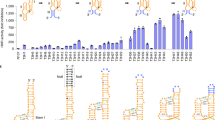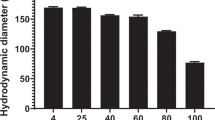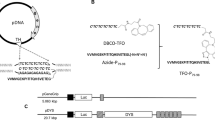Abstract
Gene transfer to the kidney can be achieved with various DNA vectors, resulting in transgene expression in glomerular or tubular districts. Controlling transgene destination is desirable for targeting defined renal cells for specific therapeutic purposes. We previously showed that injection of polyplexes into the rat renal artery resulted in transfection of proximal tubular cells. To investigate whether this process involves glomerular filtration of the DNA-containing particles, fluorescent polyethylenimine polyplexes were prepared, containing fluoresceinated poly-L-lysine. This allowed visualization of the route of the particles into the kidney. Our polyplexes were filtered through the glomerulus, since fluorescent proximal tubuli were observed. Conversely, fluorescent lipopolyplexes containing the cationic lipid DOTAP were never observed in tubular cells. Size measurements by laser light scattering showed that the mean diameter of polyplexes (93 nm) was smaller than that of lipopolyplexes (160 nm). The size of the transfecting particles is therefore a key parameter in this process, as expected by the constraints imposed by the glomerular filtration barrier. This information is relevant, in view of modulating the physico-chemical properties of DNA complexes for optimal transgene expression in tubular cells.
This is a preview of subscription content, access via your institution
Access options
Subscribe to this journal
Receive 12 print issues and online access
$259.00 per year
only $21.58 per issue
Buy this article
- Purchase on Springer Link
- Instant access to full article PDF
Prices may be subject to local taxes which are calculated during checkout





Similar content being viewed by others
References
Gabow PA . Autosomal dominant polycystic kidney disease New Engl J Med 1993 329: 332–342
Kashtan CE . Alport syndrome and thin glomerular basement membrane disease J Am Soc Nephrol 1998 9: 1736–1750
Moullier P et al. Adenoviral-mediated gene transfer to renal tubular cells in vivo Kidney Int 1994 45: 1220–1225
Isaka Y et al. Glomerulosclerosis induced by in vivo transfection of transforming growth factor-beta or platelet-derived growth factor gene into the rat kidney J Clin Invest 1993 92: 2597–2601
Heikkila P et al. Adenovirus-mediated gene transfer into kidney glomeruli using an ex vivo and in vivo kidney perfusion system – first steps towards gene therapy of Alport syndrome GeneTherapy 1996 3: 21–27
Zhu G et al. In vivo adenovirus-mediated gene transfer into normal and cystic rat kidneys Gene Therapy 1996 3: 298–304
Lai LW, Moeckel GW, Lien YH . Kidney-targeted liposome-mediated gene transfer in mice Gene Therapy 1997 4: 426–431
Boletta A et al. Nonviral gene delivery to the rat kidney with polyethylenimine Hum Gene Ther 1997 8: 1243–1251
McLean JW et al. Organ-specific endothelial cell uptake of cationic liposome–DNA complexes in mice Am J Physiol 1997 273: H387–H404
Gao X, Huang L . Potentiation of cationic liposome-mediated gene delivery by polycations Biochemistry 1996 35: 1027–1036
Vitiello L et al. Condensation of plasmid DNA with polylysine improves liposome-mediated gene transfer into established and primary muscle cells Gene Therapy 1996 3: 396–404
Kanwar YS et al. Current status of the structural and functional basis of glomerular filtration and proteinuria Semin Nephrol 1991 11: 390–413
Suh J, Paik HJ, Hwang BK . Ionization of poly(ethylenimine) and poly(allylamine) at various pHs Bioorg Chem 1994 22: 318–327
Lee RJ, Huang L . Folate-targeted, anionic liposome-entrapped polylysine-condensed DNA for tumor cell-specific gene transfer J Biol Chem 1996 271: 8481–8487
Kwoh DY et al. Stabilization of poly-L-lysine/DNA polyplexes for in vivo gene delivery to the liver Biochim Biophys Acta 1991 1444: 171–190
Couffinhal T et al. Histochemical staining following LacZ gene transfer underestimates transfection efficiency Hum Gene Ther 1997 8: 929–934
Sambrook J, Fritsch EF, Maniatis T . Molecular Cloning: A Laboratory Manual Cold Spring Harbor Laboratory Press: New York 1989
Monaco L et al. An in vitro amplification approach for the expression of recombinant proteins in mammalian cells Biotechnol Appl Biochem 1994 20: 157–171
Mohr L et al. Targeted gene transfer to hepatocellular carcinoma cells in vitro using a novel monoclonal antibody-based gene delivery system Hepatology 1999 29: 82–89
Corti M . Physics of Amphiphiles: Micelles, Vesicles and Microembulsions North-Holland: Amsterdam 1985
Monaco L . Optimising gene expression in animal cells. In: Jenkins N (ed.) Mammalian Cell Biotechnology Humana Press: Totowa, NJ 1999 39–48
Acknowledgements
This work was supported by the Italian Telethon grant A.112. The authors wish to thank Dr Umberto Fascio (Milano) for hospitality and support for the confocal microscopy observations, Professor Mario Corti (Milano) for encouragement in the laser light scattering work and Professor Daniele Cusi (Milano) for helpful discussions on the intricacies of glomerular filtration.
Author information
Authors and Affiliations
Rights and permissions
About this article
Cite this article
Foglieni, C., Bragonzi, A., Cortese, M. et al. Glomerular filtration is required for transfection of proximal tubular cells in the rat kidney following injection of DNA complexes into the renal artery. Gene Ther 7, 279–285 (2000). https://doi.org/10.1038/sj.gt.3301092
Received:
Accepted:
Published:
Issue Date:
DOI: https://doi.org/10.1038/sj.gt.3301092
Keywords
This article is cited by
-
Liposomal delivery of CRISPR/Cas9
Cancer Gene Therapy (2020)
-
Fibrin microbeads (FMB) as a 3D platform for kidney gene and cell therapy
Kidney International (2006)
-
Biodistribution and transgene expression with nonviral cationic vector/DNA complexes in the lungs
Gene Therapy (2000)



